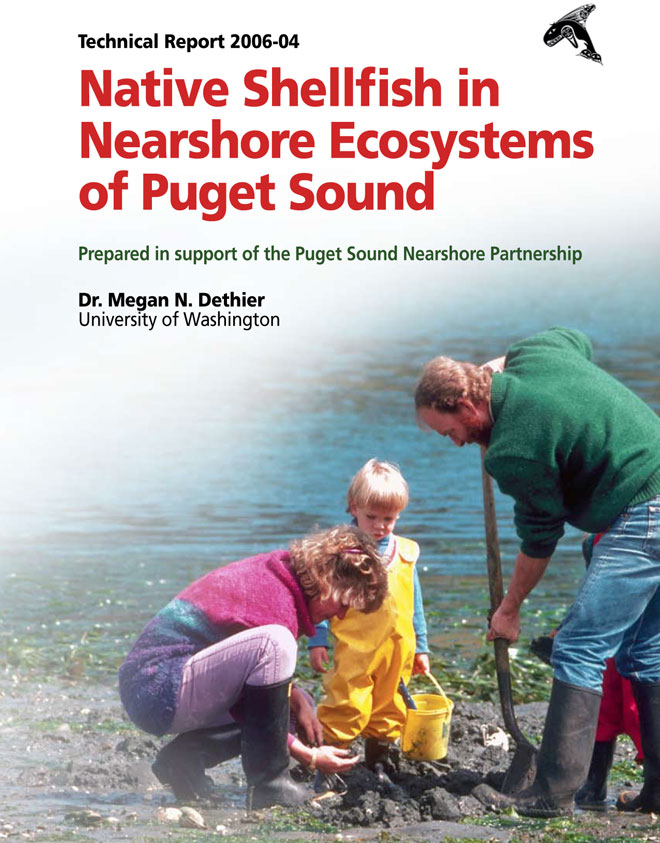Native shellfish in nearshore ecosystems of Puget Sound
This 2006 technical report for the Puget Sound Nearshore Partnership describes how shellfish have high ecological, economical, cultural, recreational value, however human activity is threatening their existence by altering their native habitat with changes in land use, shoreline modifications, stormwater, sewage and industrial discharge.

Executive Summary
Native shellfish in Washington sate are of high ecological, economic, cultural and recreational value. Ecologically, many of them filter nearshore waters, contributing to water quality. They also serve as predictable sources of food for carnivores in nearshore habitats. Others are predators that are part of the ecological balance of nearshore ecosystems. Most have larvae or juveniles that spend time in the water column, where they provide for for a variety of values fishes. Culturally, they have been a critical part of the subsistence and culture of native peoples for centuries. Economically, nearshore shellfish in Puget Sound have commercial value of almost $100 million a year; roughly $60 million of this is from sales of the non-native pacific oyster, but more than $40 million is from native crabs, clams, and mussels. Recreationally, personal harvest of shellfish is a very popular activity despite problems with water quality in many regions.
Native shellfish in Puget Sound are diverse, both in terms of species and in the ways that they use nearshore ecosystems. Species include crabs, numerous clams, the Olympia oyster, mussels, shrimp, abalone, and various others. In Puget Sound, all major shellfish species, with the exception of shrimp, use nearshore ecosystems for part or all of their life histories. This white paper focuses on geoduck clams, Dungeness crabs, hardshell clams, and Olympia oysters.
Geoduck clams are especially abundant in the south sound, buried deeply in mud or sand in the low intertidal and subtidal zones. Dungeness crabs are present throughout the state’s waters but in Puget Sound are most abundant in the northern portions. Adults are found primarily in the subtidal zone in soft sediments, but the juveniles rely heavily on intertidal habitats with structural complexity, such as eelgrass beds. Their larvae spend long periods (months) in the water column before returning to the nearshore zone to settle.
Hardshell clams, including littleneck, butter, and horse clams, are abundant throughout Puget Sound, primarily in the inter- tidal and shallow subtidal zones. All prefer sediment mixed with gravel or cobble, and their populations are sometimes enhanced by adding gravel to sandy or muddy beaches.
Native Olympia oysters grow best in shallow subtidal muddy habitats but prefer to settle as larvae onto pieces of harder substrate such as shells or pebbles. Populations of native oysters have virtually disappeared due to overharvesting and pollution, but there are increasing efforts to reestablish them…-- Summary description adapted from the report.
Citation
Dethier, M. (2006). Native Shellfish in Nearshore Ecosystems of Puget Sound. Puget Sound Nearshore Partnership Report No. 2006-04. Published by Seattle District, U.S. Army Corps of Engineers, Seattle, Washington.

